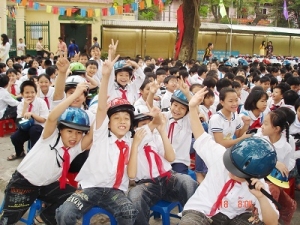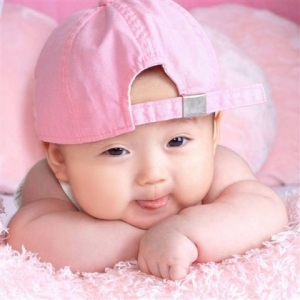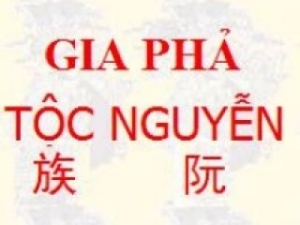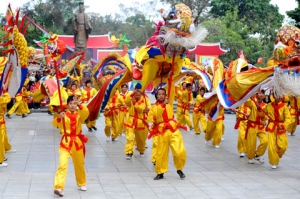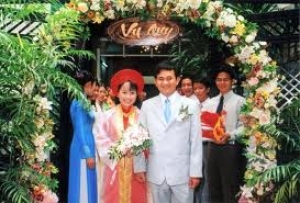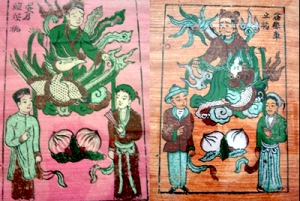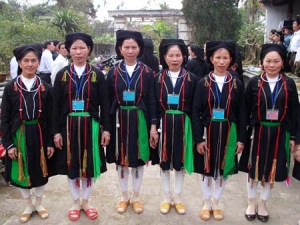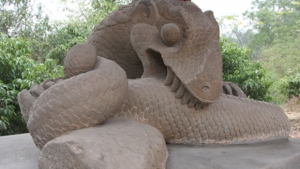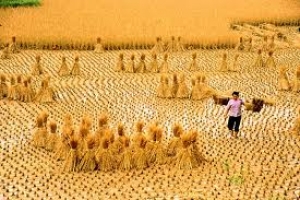
Asia Pacific Travel Team
Vietnamese Adopted Child
In Vietnam, there are three main kinds of adopted child: formal adopted child, symbolic adopted child and pretended adopted child.
Formal adopted child
There are two sub kinds of adopted child in this type. The first one is the self-made adopted child. When a family don’t have son, they adopt a child from his bother or sister children. The age of the self-made adopted child is not important. He can be very young and fed by the foster family. He can be an adult or even he has his own family. The adopted child is responsible for caring his adoptive parent when they get old and worshiping them when they die. He has to be in mourning for his adoptive parent for 3 years as normal child of the family. Therefore after his adoptive passes away, he inherits the adoptive parent’s property. The property, which is inherited by the adopted child, can be much more than the daughter of adoptive parents because in Vietnamese belief, the daughter is the child of her husband’s parent after her get marriage. The self-made adopted child is accepted to be blood-relationship by relations. In case the adoptive parent has son after adopting, the self-made adopted child become a normal former adopted child. However, he still has right to inherit property of his adoptive parent like other their other Childs.
The second type of the formal adopted child is “Hạ phong tử” adopted child. There are some cases for to become a “Hạ phong tử” adopted child. The first case, if the adoptive family does not have any children. They adopt a child when the child was born. His or her mother gets some money as compensation. She has no right to claim or feed her child. In the second case, the illegitimate child was adopted. This child is not accepted to be blood-relationship by relations like self-made adopted child. In this case, he only has to be in mourning for his adoptive parent for 1 year. In the customs of some regions, the son-in-law can be adopted when his parent-in-law don’t have a son. He does not inherit from adoptive parent but his children. In this case, he only has to be in mourning for his adoptive parent for 1 year, the bother or sister of his wife nine months and he don’t wear for anyone else of his wife’s family.
This kind of adopted child is only symbolic as its name. When a family has a child which is incompatible with his parent according to horoscope, he is sold to become an adopted child of another family. After having a baby, the family invited the foster family into his house to see the face and give a name to the baby. After the baby become a symbolic of adopted child. When this baby grows up, the family takes this child to the foster family on 5th of Tet holiday each year. The hierarchy of the symbolic adopted child in foster family bases on his age. One important point is the decedents of the symbolic adopted child and the descendants of the child of the foster family must not marriage in three generations.
When a family has difficulties in fostering his child, or they are afraid of ghost pesters his child. They bring his child to the street and then other person will adopt this child as an adopted child. Of course, the agreement between the family and foster family was made before. And some hours later, the family ransoms his child back. In this case, the adoptive which is selected by the family has to be prolific.
Nowadays, an adoptive child has interests and duties like an offspring. These interests and duties are admitted by government based on the agreements between the adoptive parent and the parent of the adoptive child or the patron of the adoptive child in case the child do not have parent.
First-Born Baby Custom
Normally in Vietnam especially in the countryside regions, three generations live under the same roof. Based on Confucianism telnet, when a girl gets marriage she has to follow her husband and live in her husband family. It has some difficulties for the wife when she is pregnant and has baby at the first time. The first-born baby custom means the wife come back to her family to have the first-born baby, and from the second child she stays at her husband’s family.
his custom is popular in Binh Tri Thien and some other regions in the north of Vietnam. In Nghe An, Ha Tinh unless the husband lives in his wife’s family in general the wife must not go to her family to have a baby. Why Vietnamese has first-born baby custom? Because in the past the married age is young, (woman from thirteen and man from sixteen can get married), and when a young wife has a baby at the first time, she does not have any experiences during pregnancy. Furthermore, she still hesitates to depend on her mother-in-law, her sister-in-law for help and it would be easier to ask for help from her mother and her sister. Next time having a baby she has experiences, she can deal with difficulties by herself so she can stay at her husband’s family. Some days before confinement, the parent-in-law or the husband goes to the wife’s family to talk with the wife’s parent to take the wife come back her family. After confinement, the baby is strong enough. The husband prepares some presents to pick her wife up and take her to his home. The grandparent-in-law of the baby is very careful to mark a smut on baby’s forehead to drive ghost away on the way coming home.
Contrary to above custom, in Ha Tinh only the daughter-in-laws can have baby at the family. If the wife is staying at her house and cannot come back her husband family, her parent has to pitch a tent temporarily for her to have a baby or she has to go to buffalo’ cage outside the house.
In case the wife is motherless, she stays at her husband family to have a baby as normal.
Recording Name on Family Annals Custom
According to the old custom, after checking the family annals, avoiding the profanation of taboo names (name of a child is same as the name of ancestors); the newborn child is officially given a name. In case of the name of the child is similar the name of ancestors, it has to be changed.
The ceremony of announcement name of a child to ancestor is very simple. It is needed only incense, betel and a glass of wine. Normally this ceremony is organized annual in ancestor death anniversary. All children which are born in each year are invited to announce their name at once. The order of each name in family annals is sorted by year. There are number of forms which are used to record the name but all of them contain the following information: name, parent, generations, branch of family, first-born child or not, date of birth and the date of recording this information.
In Vietnamese viewpoint, the daughter is the child of her husband family so her name is not recorded in family annals. But after The August Revolution, some families abolished that injustice, the name daughter is recorded on family annals
Vietnamese Engagement Ceremony
Vietnamese engagement ceremony is an important ceremony before the wedding which involve both fiancé’s and fiancée’s families.
In the past, engagement ceremony was considered very important even than the wedding ceremony because it was an official day to announce the wedding, the relationship between two families. Nowadays, it is less important and varied for each region. In the big city the engagement ceremony could be celebrated 1 day before (and 1 month in the countryside) the wedding ceremony.
Before the engagement day, each family chooses a representative. This person is a member of the family which has a happy life and a high ranking position in the family. Both of representatives do representation, exchange gifts and controlling the flow of the ceremony. Besides choosing the representatives, both families sit together to negotiate the dowry and the good time for the ceremony. The time is chosen very carefully based on the propitious time and day of lunar calendar.
The gifts are prepared by the fiancé family several days before the engagement ceremony. Traditionally the gifts was placed a number of trays. The number must be an odd number 5, 7 or 9… trays depends on the condition of the fiancé family. The gifts are covered by the red color paper or cloth. In Vietnamese beliefs, the odd number and the red color will bring luck to the young couple. The gifts include betel leaves, areca nut fruits (trầu, cau), wine, tea, husband-wife cake (bánh phu thê) and sticky rice... one of the most important gift is the whole roasted pig which placed in a large tray. Both families also choose 5, 7 or 9 people who bring and receive the gifts. These people must be young and not marriage. Boys represent for fiancé bearing the gifts and girls represent for fiancée receiving the gifts.
On the engagement day, the fiancé family brings the gifts to the fiancée family with the warmly welcome. After receiving the gifts, the young couple prays in front of the fiancée’s family altar to ask for approval of fiancée ancestors. When this ritual finishes, the fiancé give the fiancée the engaged ring.
Following the engaged ring giving, the both representatives introduced the member of both families in an order. Then both family enjoy the party which prepared by the fiancée family. It is also expected that some of gifts are returned to the fiancé family for luck before the fiancé family leaves.
The days after the engagement ceremony to the wedding ceremony, the parents of fiancée family bring the wedding cards with gifts to their friends, family members… and neighbors to invite them to the wedding party of their young couple.
Contemporary Vietnamese Traditional Weddings
In the past, a groom of 20 with an 18-year-old bride would be considered an ideal couple. Today, education, a degree of female emancipation, and the need to pursue a career have raised the figures by five or even ten years for middle-class city dwellers. Working class couples tend to marry earlier.
The pace of change
Modern traditional weddings in Vietnam differ significantly to those in the past. The most obvious change is the cost – the social pressure of ‘face’ leads some families to spend up to the equivalent of ten year’s salary. Another obvious difference is the average age of the couple.
In the past, a groom of 20 with an 18-year-old bride would be considered an ideal couple. Today, education, a degree of female emancipation, and the need to pursue a career have raised the figures by five or even ten years for middle-class city dwellers. Working class couples tend to marry earlier.
Contemporary beliefs
The tradition of matchmaking has largely faded away, but most parents have firm views – were they to decide that the prospective spouse was unsuitable, most young people would accept the verdict and break off the relationship.
Some young people seek the services of an astrologer in advance to determine whether their future liaison will be successful. If the result were negative, most would withdraw.
Women a couple of years over 30 are considered to be past their sell-by date - for men, it’s a about 35. The possibility of being left on the shelf is frightening, especially for women. As the deadline draws nearer, individuals’ and families’ criteria become looser – better an unsuitable partner than no partner!
Arranging the marriage
The first stage of marriage is usually when the young man's parents consult a fortune-teller to see whether the couple is destined to live together as husband and wife. If so, he will formally request the young woman's hand.
The actual request is made by a party comprising the young man's parents, or aunt and uncle if he is an orphan, and a go-between who go to meet the young woman's parents. The party takes gifts such as betel leaves and areca nuts, and asks what the family requires for their daughter’s hand. The young woman's parents will usually ask for a sum of money to cover the costs of the marriage preparations.
The engagement
The next stage in the process is the engagement, which, once the consent has been given, usually follows several months after. However, in some circumstances such as university or one partner working abroad, it can be much longer.
Vietnamese people believe that some days are particularly auspicious, so choosing appropriate days for the engagement and the wedding is another task for the fortune-teller.
If the fiancée or her family breaks off the engagement for any reason, all of the gifts must be returned to the young man's family. If the fiancé backs out before the big day, her family keeps them.
The engagement is a solemn ceremony. On the day, the young man will travel with his family to the young woman's house bearing gifts of betel nuts, cake, wine, cigarettes and so on. Young women wear red ao dais and a banquet is held after formal rituals are performed before the ancestral altar. The engagement ceremony is a chance for the young woman's family to meet their future son-in-law.
The wedding day
The final stage is the wedding day. Traditionally, the couple must stay apart on the day before to prevent bad luck. On the night before, the bride's mother will tend her daughter’s hair with several combs. Every comb means something, but the most important is the third comb - at that time she will ask for luck and happiness her new home.
On the big day, the bride’s family and invited guests assemble at her house to await the arrival of the bridegroom. Shortly before the groom’s party is due, the bride slips away to don her wedding dress.
Gifts from the groom's family
The groom’s parents and immediate relatives are preceded by an odd number of young men smartly dressed in shirt and tie, and dark trousers. They each carry a tray covered in a red cloth, or alternatively a large red and gold canister, containing gifts of betel leaves, areca nuts, wine, fruit, cakes, tea and so on.
In the past, they would have walked, but today most wedding parties opt for cars and change to cyclos for the last part of the journey.
Red is the dominant colour in a traditional Vietnamese wedding – it’s considered a lucky colour and will lead to a rosy future.
Upon arrival the young men dismount and are met by the same number of young women dressed in red ao dais. The men hand the gifts to the women who take them inside.
Each young woman hands her male counterpart a small amount of money to designate that they are ‘working’ – there is a superstition that being an unpaid helper at a wedding will mean that you won’t marry.
Accepting the gifts
The leading couple of the groom’s party enters the bride’s house carrying a tray of small cups of wine and invite the brides parents to take a sip. By accepting the toast, the bride’s parents symbolically agree to admit the groom’s party. A few years ago, this would be accompanied by firecrackers, but many accidents and a subsequent ban put an end to the tradition.
The groom's family introduce themselves and ask permission for their son to marry his bride. A Master of Ceremonies (usually a respected person chosen from the bride's relatives) instructs the bride’s parents to present their daughter. The bride then enters. Traditionally, this will be a red au dai. The groom will wear a dark suit or, more traditionally, a black ao dai.
The ceremony
The wedding ceremony begins in front of the altar. The bride and the groom kneel down and pray, asking their ancestors' permission to be married and their blessing on their family-to-be. The couple then turn around and bow to the bride's parents to thank them for raising and protecting her since birth.
They then bow their heads towards each other to show their gratitude and respect to their soon-to-be husband or wife. The Master of Ceremonies then advises the wedding couple on starting a new family and the two sets of parents take turns to share their experiences and give blessings.
The groom and the bride then exchange wedding rings, and the parents give the newly wedded couple gold bracelets, earrings and other valuable gifts.
The wedding banquet
After the marriage, both wedding parties leave to join guests that were not invited to the marriage ceremony at a large banquet. This is usually a large gathering, often in the hundreds and sometimes more. The groom, bride, and their family are once again introduced to the guests and everyone drinks a toast. Dinner or lunch is served at the table.
During the reception, the groom, bride, and their parents visit each table to thank their guests. In return, the guests give envelopes containing wedding cards, money gifts and a blessing to the newly wedded couple.
After the banquet, the groom’s party and the bride leave for the groom’s house, where she will live. Later, the bride’s party follows to inspect the accommodation - particularly the marital
Matchmakers in Vietnam
Marriage during the past was a family affair, as the children hadn't no priority to select their partners while their parents had. Matchmakers arranged the weddings of Vietnamese ethnic majority group- Kinh people. Before getting married, the betrothed were not allowed to touch each other. If the young woman wished to offer her suitor a quid of betel, she placed the quid on a tray. Feudal ethics forbade any direct expression of love.
If the newlyweds were happy, the matchmaker became their benefactor and was thanked with a bowl of steamed sticky rice, a boiled chicken, and a silk dress following the wedding. When the couple celebrated the one-month anniversary of their first child, the matchmaker was invited to the party.
Following an introduction by the matchmaker, the grooms family would visit the bride's family to ask after their daughter's name and age. This ceremony was an important tirst step, as the girl's age determined in her suitability as a bride. The groom's family would study the horoscopes of the prospective couple, only agreeing to a wedding if the pair's horoscopes were complementary. As well as having suitable horoscopes, the couple should come from the same social class.
Asking for wedding presents was a feudal custom that placed a lot of strain on both families. Some couples had to break up because the girl's family demanded gifts beyond the grooms family's means. The brides family might request dresses, bottles of wine, cakes, betel nuts, rice, pigs, chickens, jewelry, and money. Sometimes, the groom's family would go deep into debt, forcing the young couple to spend years paying back the costs incurred by their wedding. Resentment between the bride and groom and their respective families was inevitable.
A traditional wedding ceremony involved a great many gifts. Phu the cakes were mandatory. Made of rice flour, sugar, coconut and green beans, these cakes consist of a round filling between two square layers - said to represent the earth and the sky. The cakes are associated with loyalty, flexibility and honesty.
To raise pigs you must collect ivater ferns. To get married you must be pay "way ahead" to the village.
"Way ahead" was a sum of money that the grooms family offered to the girl's home village. If the boy and the girl were natives of the same village, the groom's family still had to pay "way ahead", although the sum was smaller. Only after receiving the "way ahead" would the village officials issue a marriage certificate. The collected money was to be used for public works, like sinking a well or building a road.
An hour or two before it was time to fetch the bride, the groom's uncle or aunt would go to the brides house to discuss the correct time to pick up the bride. This custom allowed the families to solve last-minute obstacles of poor weather or heavy traffic.
At the bride's home, the bride and groom worshiped at the ancestral altar, praying that the ancestors would support their future and ensure them a happy life. After that, the bride and groom offered a tray of betel nuts and cigarettes to thek guests, starting with the eldest and most respected guests. Finally, the bride and groom kowtowed to the brides parents. The brides parents reciprocated with a small gift, normally earrings or some money.
The mother-of-the-bride was not permitted to send her daughter off to the grooms house. It was considered the fathers right to arrange the marriage. Often, the bride would cry as she worried about her future among strangers, while her mother would cry at the thought of losing her child. According to custom, the mother was forbidden from watching her daughters departure.
Upon arrival at the grooms house, other customs were observed. In the central provinces of Nghe An-Ha Tinh, the mother-in-law would welcome the bride by placing a water scoop and a large brass pot full of water beside the front gate. Inside the pot she would throw a few coins. The water symbolized her blessing for the bride, while the coins showed that the new daughter-in-law had access to private capital.
After honoring the groom's ancestors, the mother-in-law led the bride into the wedding room. Here, a respected older man or woman with both a son and a daughter had spread a new flowered sedge mat on the bed. This tradition was designed to ensure that the couple would have a son and a daughter and a happy future.
In either parts of Vietnam, the mother-in-law was not allowed to meet the bride, but instead took a pot of lime and went to a neighbors house. This custom showed that, while she was passing authority to her daughter-in-law, she retained the lime pot, symbolic of a woman's role in managing the housework.
In the past, most newlyweds were teenagers. It was common for girls of 13 and boys of 16 to marry. Bridesmaids would often accompany the bride to the groom's house and spend a few days teaching the bride how to become a wife and daughter-in-law. The bridesmaids typically departed after two or four days, when the newlyweds performed a custom known as lot mat, in which they returned to the bride's house to visit her parents and bring them some gifts. This tradition expressed the children's filial piety towards their parents.
Today, young people in Vietnam are free to choose their own partners. To outsiders, weddings may appear very Westernized, as most brides don white gowns, while the grooms family hosts a large reception, often in a restaurant or hotel. Behind the scenes, however, many of the old traditions persist. From the offering of betel nuts to the ceremonial laying down of the newlyweds' sedge mat, wedding rituals have retained their symbolic value.
Sán Dìu in Quang Ninh
Customs and habits: They can mainly be found living in villages and hamlets. Houses feature walls and roofs of hooked tiles. The Sán Dìu practices the cult of ancestors, and also worship their own particular genies.
Language: Hán language.
Culture: There are many unique legends, poems and songs, with themes ranging from nature to familial and social relationships which is expressed "King Toad" story; dance: "stick dance". Musical instruments: "Tù Và" is made by buffalo's horns, Flute "sôna" made by snail's shell.
Traditional clothing: The Sán Dìu has gradually adopted the Kinh style of dress.
Economy: The Sán Dìu engages in rice farming practices with high level.
Dragon of mystery
The “Master Dragon” statue worshipped at Le Van Thinh’s Temple in Bac Ninh Province. The origins of a formidable statue of a dragon-like creature excavated in Bac Ninh Province remain unclear.
In 1992, Phan Dinh Pho, the former keeper of Great Tutor Le Van Thinh’s Temple in Bac Ninh Province happened upon a rock jutting out from the ground in front of the temple.
Pho, who passed away in 1993, removed some dirt and stones around the rock and found that it was carved, so he asked villagers to dig it up. They surprisingly unearthed a stone statue of a creature with features resembling a traditional Asian dragon replete with scales, clawed feet and fangs.
The statue, however, has a very unusual features which have never appeared in Chinese or Vietnamese dragon depictions before.
The animal and its thick scales are carved out of a whole rock. Its front legs are stretched out, with 10 toes with sharp claws to its body. The head, with staring eyes, droops while the mouth is wide open, with rows of pointed fangs biting its trunk. The right ear is filled in but the left ear is empty.
The overall image generates a sense of extreme agony and pain.
The three-ton statue was named “Master Dragon” by locals and has since been worshiped at an altar beside the temple.
Tiger tutor
The “Master Dragon” statue was found at the temple of Le Van Thinh, Vietnam’s first doctor who was famous for being talented in many fields.
Thinh, a resident of Dong Cuu Hamlet of Gia Dinh District (now Bac Ninh Province’s Gia Binh District), was the top graduate in Vietnam’s first official examination held in 1075 under King Ly Nhan Tong’s reign and was invited to work as an army official. He was then promoted to the position of Thai Su (Great Tutor) in 1085 and held it for 12 years until the legendary case of “Tiger transformation” occurred.
This case was written up in the 15th century Dai Viet Su ky Toan thu (The Complete Book of the Great Viet’s History). The book said Thinh turned into a tiger to attack the king during a cruise in a boat around West Lake. He was captured by a fisherman and subsequently exiled by the ruler.
It is said that on his way home from exile, Thinh passed away at To Temple in Bac Ninh Province’s Thuan Thanh District and was worshipped as the village’s patron god. His tomb remains there today.
Although accused of treachery and NG SON assassination by the court, Thinh was still respected by the people and was worshipped in many parts of the north as a patron god.
The truth of the incident has remained a mystery until the present day but most modern Vietnamese historians believe the case was a scheme against Thinh by his political opponents.
Experts’ perspectives
The dragon statue has been considered by some locals and experts as an artwork displaying the pain and silent anger endured by Thinh because of his unjust treatment.
“The dragon statue found at Great Tutor Thinh’s Temple is probably the image of a person portrayed as one who failed in political affairs and suffered great pain,” art critic Phan Cam Thuong said. “It is Great Tutor Thinh.”
The statue, Thuong says, could have been made in the post-Le Dynasty (15th century) era based on its correlations with other stone relics from the period found in Bac Ninh Province.
Others believe “Master Dragon” is the image of King Ly Nhan Tong, showing his pain because he had listened to only one side – depicted by one closed ear and one open ear – and wrongly punished Thinh who was an upstanding mandarin and the king’s own teacher.
Ta Chi Dai Truong, a Vietnamese historian living in the US, holds a contrasting view. He claims it is necessary to examine the statue as a separate work of art and not tie it to Thinh’s case because doing so would place a real object within a mythological context.
Vietnam National University of Hanoi University of Social Sciences and Humanities lecturer Nguyen Hung Vi, who has spent years studying the historical background of Great Tutor Thinh, asserts that “Master Dragon” is an exclusive statue.
The work belongs to the Ly Dynasty or a much earlier period instead the post-Le Dynasty, according to Vi, who added “I don’t believe this is an image that symbolizes Great Tutor Thinh or King Ly Nhan Tong.”
The statue continues to draw attention from the public and many experts in fields of art, history and archeology who yearn to solve its mystery.
Reported by Cam Linh – Tr. Son
Match makers in Vietnam
Generations ago, marriage was a family affair, as parents select their child’s spouse.
In the past, the weddings of Kinh people - Vietnam's ethnic majority - were arranged by matchmakers. Before marriage, the betrothed were not allowed to touch each other. If the young woman wished to offer her suitor a quid of betel, she placed the quid on a tray. Feudal ethics forbade any direct expression of love.
If the newlyweds were happy, the matchmaker became their benefactor and was thanked with a bowl of steamed sticky rice, a boiled chicken, and a silk dress following the wedding. When the couple celebrated the one-month anniversary of their first child, the matchmaker was invited to the party.
Following an introduction by the matchmaker, the grooms family would visit the bride's family to ask after their daughter's name and age. This ceremony was an important first step, as the girl's age determined in her suitability as a bride. The groom's family would study the horoscopes of the prospective couple, only agreeing to a wedding if the pair's horoscopes were complementary. As well as having suitable horoscopes, the couple should come from the same social class.
Asking for wedding presents was a feudal custom that placed a lot of strain on both families. Some couples had to break up because the girl's family demanded gifts beyond the grooms family's means. The brides family might request dresses, bottles of wine, cakes, betel nuts, rice, pigs, chickens, jewelry, and money. Sometimes, the groom's family would go deep into debt, forcing the young couple to spend years paying back the costs incurred by their wedding. Resentment between the bride and groom and their respective families was inevitable.
A traditional wedding ceremony involved a great many gifts. Phu the cakes were mandatory. Made of rice flour, sugar, coconut and green beans, these cakes consist of a round filling between two square layers - said to represent the earth and the sky. The cakes are associated with loyalty, flexibility and honesty.
To raise pigs you must collect irater ferns. To get married you must be pay "way ahead" to the village.
"Way ahead" was a sum of money that the grooms family offered to the girl's home village. If the boy and the girl were natives of the same village, the groom's family still had to pay "way ahead", although the sum was smaller. Only after receiving the "way ahead" would the village officials issue a marriage certificate. The collected money was to be used for public works, like sinking a well or building a road.
An hour or two before it was time to fetch the bride, the groom's uncle or aunt would go to the brides house to discuss the correct time to pick up the bride. This custom allowed the families to solve last-minute obstacles of poor weather or heavy traffic.
At the bride's home, the bride and groom worshiped at the ancestral altar, praying that the ancestors would support their future and ensure them a happy life. After that, the bride and groom offered a tray of betel nuts and cigarettes to thek guests, starting with the eldest and most respected guests. Finally, the bride and groom kowtowed to the brides parents. The brides parents reciprocated with a small gift, normally earrings or some money.
The mother-of-the-bride was not permitted to send her daughter off to the grooms house. It was considered the fathers right to arrange the marriage. Often, the bride would cry as she worried about her future among strangers, while her mother would cry at the thought of losing her child. According to custom, the mother was forbidden from watching her daughters departure.
Upon arrival at the grooms house, other customs were observed. In the central provinces of Nghe An-Ha Tinh, the mother-in-law would welcome the bride by placing a water scoop and a large brass pot full of water beside the front gate. Inside the pot she would throw a few coins. The water symbolized her blessing for the bride, while the coins showed that the new daughter-in-law had access to private capital.
After honoring the groom's ancestors, the mother-in-law led the bride into the wedding room. Here, a respected older man or woman with both a son and a daughter had spread a new flowered sedge mat on the bed. This tradition was designed to ensure that the couple would have a son, a daughter and a happy future.
In ether parts of Vietnam, the mother-in-law was not allowed to meet the bride, but instead took a pot of lime and went to a neighbors house. This custom showed that, while she was passing authority to her daughter-in-law, she retained the lime pot, symbolic of a woman's role in managing the housework.
In the past, most newlyweds were teenagers. It was common for girls of 13 and boys of 16 to marry. Bridesmaids would often accompany the bride to the groom's house and spend a few days teaching the bride how to become a wife and daughter-in-law. The bridesmaids typically departed after two or four days, when the newlyweds performed a custom known as lot mat, in which they returned to the bride's house to visit her parents and bring them some gifts. This tradition expressed the children's filial piety towards their parents.
Today, young people in Vietnam are free to choose their own partners. To outsiders, weddings may appear very westernized, as most brides don white gowns, while the grooms family hosts a large reception, often in a restaurant or hotel. Behind the scenes, however, many of the old traditions persist. From the offering of betel nuts to the ceremonial laying down of the newlyweds' sedge mat, wedding rituals have retained their symbolic value.
Source:waytovietnam.com
The Water Culture – a unique culture of Vietnam
Vietnam has a long, war-torn history and is physically an elongated, beautiful and diverse country. Both history and geography have had a dramatic impact on the people. There are significant differences across generations and between provinces.
Nowadays, the culture of Vietnamese people is a topic that little written about. However, there still have many cultural values which have existed for very long time till now, and it will be very excited for who want to understand Vietnam culture, especially for foreign tourists travel to Vietnam. Therefore, Vietnam culture has also become an important point attracting tours in Vietnam.
Coming here , visitors will be impressed by the culture – the water culture.
For centuries, land, water and people of the Mekong Delta have lived as one.
The rainy season inevitably comes with river erosion. Some people wonder why others still build houses on river and canal banks despite the danger. The reasons are numerous: A lack of housing land; these locations are ideal for trade; or their homes have been there for generations, thus breeding familiarity. Nonetheless, there seem to be other profound reasons that we sometimes do not thoroughly comprehend, such as “the water culture!”
Residents of the Mekong Delta have seen water since the moment they were born. When they started learning to walk is when they also began to play with water. The childhood memories of quite a few are imprinted with the sight of water, bathing in the river or rain or launching paper boats.
While growing up, many already helped their families choose the tides to paddle around or to water rice fields. Some simply sat on the river bank, gazing at the rippling moonlight whenever a fish bit the bait. There are also plenty of brides who have to take hours-long boat trips on the river when leaving for their husbands’ homes, and anxious grooms fearing the late flow of the tide would delay their journeys to pick up their brides.
Water also offers gathering locations for the community to trade, which gradually turns into floating markets. Therefore, wherever rivers and canals converge, there is a market, such as Nga Bay (Seven-junction) market. Wherever rivers and roads meet, a market emerges. Walking along the roads of the Mekong Delta, it is easy to spot a market right on a bridge slope.
For generations, the Mekong Delta inhabitants have regarded water and land as one. Where there is land, or water, there are houses. Traffic, trade, transport and fishing activities are just as dynamic as they are on land.
Thus, houses built close to one another along rivers and canals are always within eyesight. Where there is less risk of flooding during high-tide season, people build houses on the ground; where the water is deep, stilt houses will be built. Boats are parked right beneath such houses for the convenience of transport as well as shelter from the sun or rain.
The reason why water is friendly to people and people are not afraid of it is because it brings people a great deal of free services. These include daily activities; growing rice, fruit and vegetables; raising poultry, fish and shrimps; even for deacidifying and desalinating fields, ponds and farms.
When troubled by sorrow, worries, business losses or frequently sick children, people also rely on water flows to bring away the bad luck. Offerings include incense sticks and candles, which are all put on a raft made of banana trees and decorated with colorful flags and flowers. The raft is then launched into the river, which is known as worshiping the river deity.
The mingling of land, water and human beings for centuries runs deep in the veins of the Mekong Delta people, making them free, determined and fearless. Invaluable life experiences have been summed up and passed on to succeeding generations through folk sayings, such as “Flowing water will wear away stone,” or “Shore pushed by water eventually collapses.” Such proverbs carry philosophical meanings and educate people about self-discipline, treatment of others as well as nature.
Although we are living in an industrial era, it seems the culture of water still sustains its value.


